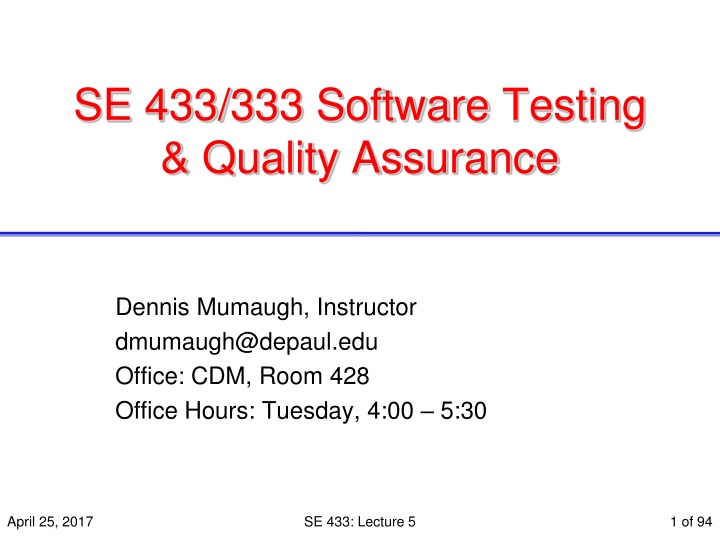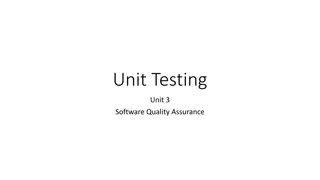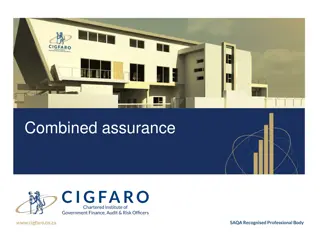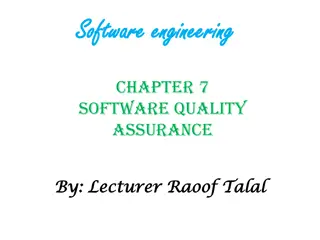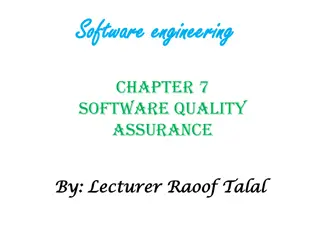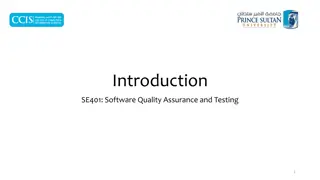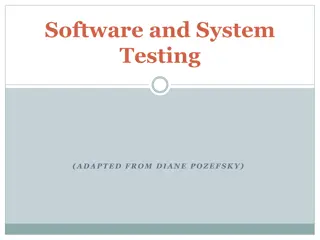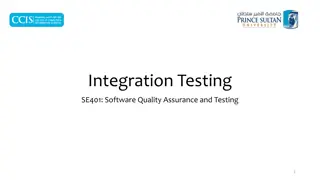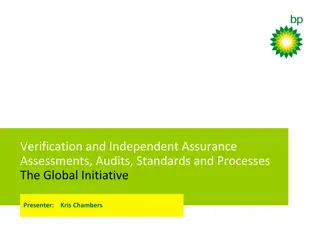Software Testing & Quality Assurance Lecture Series
Dive into a comprehensive lecture series on Software Testing and Quality Assurance with Instructor Dennis Mumaugh. Explore topics like Black Box Testing, JUnit, Ant, test case implementation, and more. Engage in assignments involving JUnit, Ant, and unit test suites design. Gain insights on the tester's mindset and the importance of thorough testing in software development. Stay informed and educated with thought-provoking quotes and valuable resources provided in each lecture.
Download Presentation

Please find below an Image/Link to download the presentation.
The content on the website is provided AS IS for your information and personal use only. It may not be sold, licensed, or shared on other websites without obtaining consent from the author.If you encounter any issues during the download, it is possible that the publisher has removed the file from their server.
You are allowed to download the files provided on this website for personal or commercial use, subject to the condition that they are used lawfully. All files are the property of their respective owners.
The content on the website is provided AS IS for your information and personal use only. It may not be sold, licensed, or shared on other websites without obtaining consent from the author.
E N D
Presentation Transcript
SE 433/333 Software Testing & Quality Assurance Dennis Mumaugh, Instructor dmumaugh@depaul.edu Office: CDM, Room 428 Office Hours: Tuesday, 4:00 5:30 April 25, 2017 SE 433: Lecture 5 1 of 94
Administrivia Comments and Feedback Grading: have not been assigned a grader, so I get to do it myself. Working. Midterm Examination this week [April 27-May 1] Will use the Desire2Learn System (https://d2l.depaul.edu/) Using Desire2Learn [See note]. Details Things to avoid April 25, 2017 SE 433: Lecture 5 2 of 94
SE 433 Class 5 Topic: Black Box Testing Part 2, JUnit & Ant Reading: Pezze and Young: Chapter 10 JUnit documentation: http://junit.org Ant documentation: http://ant.apache.org Ant introductory tutorial: http://www.vogella.com/tutorials/ApacheAnt/article.html An example of using JUnit with Ant: JUnit3.zip in D2L Articles on the Class Page and Reading List April 25, 2017 SE 433: Lecture 5 3 of 94
Assignment 6 Using JUnit and Ant Due Date: May 4, 2017, Objective The objective of this assignment is to run JUnit tests using Ant. Requirements Install standalone JUnit and Ant. Write an Ant build file, build.xml, to compile and run the JUnit tests you have developed in Assignment 3 & 4. You should define a target named testAll that accomplishes all the tasks above. April 25, 2017 SE 433: Lecture 5 4 of 94
Assignment 7 Part 2: Test Case Implementation Due Date: May 11, 2017 The objective of this assignment is to design unit test suites using black-box techniques, implementing the test suites using JUnit, and run the test suites using Ant. The binary code of both programs under test is provided in a zip file named classes.zip. Unzip this file, you will find a directory named classes, that contains the compiled byte code of programs under test. The programs match the descriptions given in the assignment. However, the implementations may contain defects. You must include the classes directory in your classpath to run or test the programs. April 25, 2017 SE 433: Lecture 5 5 of 94
Thought for the Day You must be a constructive schizophrenic. Be clear about the difference between your role as a programmer and as a tester. The tester in you must be suspicious, uncompromising, hostile, and compulsively obsessed with destroying, utterly destroying, the programmer s software. The tester in you is your Mr. Hyde your Incredible Hulk. He must exercise what Gruenberger calls low cunning. Boris Beizer April 25, 2017 SE 433: Lecture 5 6 of 94
Black-box Testing April 25, 2017 SE 433: Lecture 5 7 of 94
Black Box Testing Testing software against a specification of its external behavior without knowledge of internal implementation details Can be applied to software units (e.g., classes) or to entire programs External behavior is defined in API docs, Functional specs, Requirements specs, etc. Because black box testing purposely disregards the program's control structure, attention is focused primarily on the information domain (i.e., data that goes in, data that comes out) The Goal: Derive sets of input conditions (test cases) that fully exercise the external functionality April 25, 2017 SE 433: Lecture 5 8 of 94
Black-box Testing Categories Incorrect or missing functions Interface errors Usability problems Concurrency and timing errors Errors in data structures or external data base access Behavior or performance errors Initialization and termination errors Unlike white box testing, black box testing tends to be applied later in the development process April 25, 2017 SE 433: Lecture 5 9 of 94
Questions answered by Black-box Testing How is functional validity tested? How are system behavior and performance tested? What classes of input will make good test cases? Is the system particularly sensitive to certain input values? How are the boundary values of a data class isolated? What data rates and data volume can the system tolerate? What effect will specific combinations of data have on system operation? April 25, 2017 SE 433: Lecture 5 10 of 94
The Information Domain: inputs and outputs Inputs Individual input values Try many different values for each individual input Combinations of inputs Individual inputs are not independent from each other Programs process multiple input values together, not just one at a time Try many different combinations of inputs in order to achieve good coverage of the input domain Ordering and Timing of inputs In addition to the particular combination of input values chosen, the ordering and timing of the inputs can also make a difference April 25, 2017 SE 433: Lecture 5 11 of 94
The Information Domain: inputs and outputs Defining the input domain Boolean value T or F Numeric value in a particular range -99 <= N <= 99 Integer, Floating point Non-negative One of a fixed set of enumerated values {Jan, Feb, Mar, } {Visa, MasterCard, Discover, } Formatted strings Phone numbers File names URLs Credit card numbers Regular expressions April 25, 2017 SE 433: Lecture 5 12 of 94
Black Box Testing Equivalence classes April 25, 2017 SE 433: Lecture 5 13 of 94
Equivalence Partitioning A black-box testing method that divides the input domain of a program into classes of data from which test cases are derived An ideal test case single-handedly uncovers a complete class of errors, thereby reducing the total number of test cases that must be developed Test case design is based on an evaluation of equivalence classes for an input condition An equivalence class represents a set of valid or invalid states for input conditions From each equivalence class, test cases are selected so that the largest number of attributes of an equivalence class are exercised at once April 25, 2017 SE 433: Lecture 5 14 of 94
Equivalence Partitioning Typically the universe of all possible test cases is so large that you cannot try them all You have to select a relatively small number of test cases to actually run Which test cases should you choose? Equivalence partitioning helps answer this question April 25, 2017 SE 433: Lecture 5 15 of 94
Equivalence Partitioning Partition the test cases into "equivalence classes Each equivalence class contains a set of "equivalent" test cases Two test cases are considered to be equivalent if we expect the program to process them both in the same way (i.e., follow the same path through the code) If you expect the program to process two test cases in the same way, only test one of them, thus reducing the number of test cases you have to run April 25, 2017 SE 433: Lecture 5 16 of 94
Equivalence Partitioning First-level partitioning: Valid vs. Invalid test cases Valid Invalid April 25, 2017 SE 433: Lecture 5 17 of 94
Equivalence Partitioning Partition valid and invalid test cases into equivalence classes April 25, 2017 SE 433: Lecture 5 18 of 94
Equivalence Partitioning Create a test case for at least one value from each equivalence class April 25, 2017 SE 433: Lecture 5 19 of 94
Equivalence Partitioning When designing test cases, you may use different definitions of equivalence , each of which will partition the test case space differently Example: int Add(n1, n2, n3, ) Equivalence Definition 1: partition test cases by the number of inputs (1, 2, 3, etc.) Equivalence Definition 2: partition test cases by the number signs they contain (positive, negative, both) Equivalence Definition 3: partition test cases by the magnitude of operands (large numbers, small numbers, both) Etc. April 25, 2017 SE 433: Lecture 5 20 of 94
Equivalence Partitioning When designing test cases, you may use different definitions of equivalence , each of which will partition the test case space differently Example: string Fetch(URL) Equivalence Definition 1: partition test cases by URL protocol ( http , https , ftp , file , etc.) Equivalence Definition 2: partition test cases by type of file being retrieved (HTML, GIF, JPEG, Plain Text, etc.) Equivalence Definition 3: partition test cases by length of URL (very short, short, medium, long, very long, etc.) Same host Etc. April 25, 2017 SE 433: Lecture 5 21 of 94
Equivalence Partitioning Test multiple values in each equivalence class. Often you re not sure if you have defined the equivalence classes correctly or completely, and testing multiple values in each class is more thorough than relying on a single value. April 25, 2017 SE 433: Lecture 5 22 of 94
Guidelines for Defining Equivalence Classes If an input condition specifies a range, one valid and two invalid equivalence classes are defined Input range: 1 10 Eq classes: {1..10}, {x < 1}, {x > 10} If an input condition requires a specific value, one valid and two invalid equivalence classes are defined Input value: 250 Eq classes: {250}, {x < 250}, {x > 250} If an input condition specifies a member of a set, one valid and one invalid equivalence class are defined Input set: {-2.5, 7.3, 8.4} Eq classes: {-2.5, 7.3, 8.4}, {any other x} If an input condition is a Boolean value, one valid and one invalid class are define Input: {true condition} Eq classes: {true condition}, {false condition} April 25, 2017 SE 433: Lecture 5 23 of 94
Equivalence Partitioning - examples Input Valid Equivalence Classes Invalid Equivalence Classes A integer N such that: -99 <= N <= 99 ? ? Phone Number Area code: [200, 999] Prefix: (200, 999] Suffix: Any 4 digits ? ? April 25, 2017 SE 433: Lecture 5 24 of 94
Equivalence Partitioning - examples Input Valid Equivalence Classes Invalid Equivalence Classes A integer N such that: -99 <= N <= 99 [-99, -10] [-9, -1] 0 [1, 9] [10, 99] ? Phone Number Area code: [200, 999] Prefix: (200, 999] Suffix: Any 4 digits ? ? April 25, 2017 SE 433: Lecture 5 25 of 94
Equivalence Partitioning - examples Input Valid Equivalence Classes Invalid Equivalence Classes A integer N such that: -99 <= N <= 99 [-99, -10] [-9, -1] 0 [1, 9] [10, 99] < -99 > 99 Malformed numbers {12-, 1-2-3, } Non-numeric strings {junk, 1E2, $13} Empty value Phone Number Area code: [200, 999] Prefix: (200, 999] Suffix: Any 4 digits ? ? April 25, 2017 SE 433: Lecture 5 26 of 94
Equivalence Partitioning - examples Input Valid Equivalence Classes Invalid Equivalence Classes A integer N such that: -99 <= N <= 99 [-99, -10] [-9, -1] 0 [1, 9] [10, 99] < -99 > 99 Malformed numbers {12-, 1-2-3, } Non-numeric strings {junk, 1E2, $13} Empty value Phone Number Area code: [200, 999] Prefix: (200, 999] Suffix: Any 4 digits 555-5555 (555)555-5555 555-555-5555 200 <= Area code <= 999 200 < Prefix <= 999 ? April 25, 2017 SE 433: Lecture 5 27 of 94
Equivalence Partitioning - examples Input Valid Equivalence Classes Invalid Equivalence Classes A integer N such that: -99 <= N <= 99 [-99, -10] [-9, -1] 0 [1, 9] [10, 99] < -99 > 99 Malformed numbers {12-, 1-2-3, } Non-numeric strings {junk, 1E2, $13} Empty value Phone Number Area code: [200, 999] Prefix: (200, 999] Suffix: Any 4 digits 555-5555 (555)555-5555 555-555-5555 200 <= Area code <= 999 200 < Prefix <= 999 Invalid format 5555555, (555)(555)5555, etc.. Area code < 200 or > 999 Area code with non-numeric characters Similar for Prefix and Suffix April 25, 2017 SE 433: Lecture 5 28 of 94
Boundary Value Analysis A greater number of errors occur at the boundaries of the input domain rather than in the "center" Boundary value analysis is a test case design method that complements equivalence partitioning It selects test cases at the edges of a class It derives test cases from both the input domain and output domain April 25, 2017 SE 433: Lecture 5 29 of 94
Guidelines for Boundary Value Analysis 1. If an input condition specifies a range bounded by values a and b, test cases should be designed with values a and b as well as values just above and just below a and b If an input condition specifies a number of values, test case should be developed that exercise the minimum and maximum numbers. Values just above and just below the minimum and maximum are also tested Apply guidelines 1 and 2 to output conditions; produce output that reflects the minimum and the maximum values expected; also test the values just below and just above If internal program data structures have prescribed boundaries (e.g., an array), design a test case to exercise the data structure at its minimum and maximum boundaries 2. April 25, 2017 SE 433: Lecture 5 30 of 94
Boundary Value Analysis When choosing values from an equivalence class to test, use the values that are most likely to cause the program to fail Errors tend to occur at the boundaries of equivalence classes rather than at the "center" If (200 < areaCode && areaCode < 999) { // valid area code } Wrong! If (200 <= areaCode && areaCode <= 999) { // valid area code } Testing area codes 200 and 999 would catch this error, but a center value like 770 would not In addition to testing center values, we should also test boundary values Right on a boundary Very close to a boundary on either side April 25, 2017 SE 433: Lecture 5 31 of 94
Boundary Value Analysis Create test cases to test boundaries of equivalence classes April 25, 2017 SE 433: Lecture 5 32 of 94
Boundary Value Analysis - examples Input Boundary Cases A number N such that: -99 <= N <= 99 ? ? Phone Number Area code: [200 .. 999] Prefix: [200 .. 999] Suffix: Any 4 digits April 25, 2017 SE 433: Lecture 5 33 of 94
Boundary Value Analysis - examples Input Boundary Cases A number N such that: -99 <= N <= 99 -100, -99, -98 -10, -9 -1, 0, 1 9, 10 98, 99, 100 Phone Number Area code: [200 .. 999] Prefix: [200 .. 999] Suffix: Any 4 digits ? April 25, 2017 SE 433: Lecture 5 34 of 94
Boundary Value Analysis - examples Input Boundary Cases A number N such that: -99 <= N <= 99 -100, -99, -98 -10, -9 -1, 0, 1 9, 10 98, 99, 100 Phone Number Area code: [200 .. 999] Prefix: [200 .. 999] Suffix: Any 4 digits Area code: 199, 200, 201 Area code: 998, 999, 1000 Prefix: 200, 199, 198 Prefix: 998, 999, 1000 Suffix: 3 digits, 5 digits April 25, 2017 SE 433: Lecture 5 35 of 94
Boundary Value Analysis - examples Numeric values are often entered as strings which are then converted to numbers internally [int x = atoi(str);] This conversion requires the program to distinguish between digits and non-digits A boundary case to consider: Will the program accept / and : as digits? Char ASCII / 0 1 2 3 4 5 6 7 8 9 : 47 48 49 50 51 52 53 54 55 56 57 58 April 25, 2017 SE 433: Lecture 5 36 of 94
Mainstream usage testing Don't get so wrapped up in testing boundary cases that you neglect to test "normal" input values Values that users would typically enter during mainstream usage April 25, 2017 SE 433: Lecture 5 37 of 94
General Testing April 25, 2017 SE 433: Lecture 5 38 of 94
Testing for race conditions and other timing dependencies Many systems perform multiple concurrent activities Operating systems manage concurrent programs, interrupts, etc. Servers service many clients simultaneously Applications let users perform multiple concurrent actions Test a variety of different concurrency scenarios, focusing on activities that are likely to share resources (and therefore conflict) "Race conditions" are bugs that occur only when concurrent activities interleave in particular ways, thus making them difficult to reproduce Test on hardware of various speeds to ensure that your system works well on both slower and faster machines April 25, 2017 SE 433: Lecture 5 39 of 94
Performance Testing Measure the system's performance Running times of various tasks Memory usage, including memory leaks Network usage (Does it consume too much bandwidth? Does it open too many connections?) Disk usage (Is the disk footprint reasonable? Does it clean up temporary files properly?) Process/thread priorities (Does it play well with other applications, or does it hog the whole machine?) April 25, 2017 SE 433: Lecture 5 40 of 94
Limit Testing Test the system at the limits of normal use Test every limit on the program's behavior defined in the requirements Maximum number of concurrent users or connections Maximum number of open files Maximum request size Maximum file size Etc. What happens when you go slightly beyond the specified limits? Does the system's performance degrade dramatically, or gracefully? April 25, 2017 SE 433: Lecture 5 41 of 94
Stress Testing Test the system under extreme conditions (i.e., beyond the limits of normal use) Create test cases that demand resources in abnormal quantity, frequency, or volume Low memory conditions Disk faults (read/write failures, full disk, file corruption, etc.) Network faults Unusually high number of requests Unusually large requests or files Unusually high data rates (what happens if the network suddenly becomes ten times faster?) Even if the system doesn't need to work in such extreme conditions, stress testing is an excellent way to find bugs April 25, 2017 SE 433: Lecture 5 42 of 94
Security Testing Any system that manages sensitive information or performs sensitive functions may become a target for intrusion (i.e., hackers) How feasible is it to break into the system? Learn the techniques used by hackers Try whatever attacks you can think of Hire a security expert to break into the system If somebody broke in, what damage could they do? If an authorized user became disgruntled, what damage could they do? April 25, 2017 SE 433: Lecture 5 43 of 94
Usability Testing Is the user interface intuitive, easy to use, organized, logical? Does it frustrate users? Are common tasks simple to do? Does it conform to platform-specific conventions? Get real users to sit down and use the software to perform some tasks Watch them performing the tasks, noting things that seem to give them trouble Get their feedback on the user interface and any suggested improvements Report bugs for any problems encountered April 25, 2017 SE 433: Lecture 5 44 of 94
Recovery Testing Try turning the power off or otherwise crashing the program at arbitrary points during its execution Does the program come back up correctly when you restart it? Was the program s persistent data corrupted (files, databases, etc.)? Was the extent of user data loss within acceptable limits? Can the program recover if its configuration files have been corrupted or deleted? What about hardware failures? Does the system need to keep working when its hardware fails? If so, verify that it does so. April 25, 2017 SE 433: Lecture 5 45 of 94
Configuration Testing Test on all required hardware configurations CPU, memory, disk, graphics card, network card, etc. Test on all required operating systems and versions thereof Virtualization technologies such as VMWare and Virtual PC are very helpful for this Test as many Hardware/OS combinations as you can Test installation programs and procedures on all relevant configurations April 25, 2017 SE 433: Lecture 5 46 of 94
Compatibility Testing Test to make sure the program is compatible with other programs it is supposed to work with Ex: Can Word 12.0 load files created with Word 11.0? Ex: "Save As Word, Word Perfect, PDF, HTML, Plain Text" Ex: "This program is compatible with Internet Explorer and Firefox Test all compatibility requirements April 25, 2017 SE 433: Lecture 5 47 of 94
Documentation Testing Test all instructions given in the documentation to ensure their completeness and accuracy For example, How To ... instructions are sometimes not updated to reflect changes in the user interface Test user documentation on real users to ensure it is clear and complete April 25, 2017 SE 433: Lecture 5 48 of 94
JUnit & Ant April 25, 2017 SE 433: Lecture 5 49 of 94
Stand Alone JUnit & Ant Ant a versatile Java build tool Control and execute various tasks in development, testing, configuration, distribution, & installation. Full introduction a little later Run all the tasks independent from IDE Command-line, terminal mode Batch mode, continuous integration Full range of configuration options April 25, 2017 SE 433: Lecture 5 50 of 94
